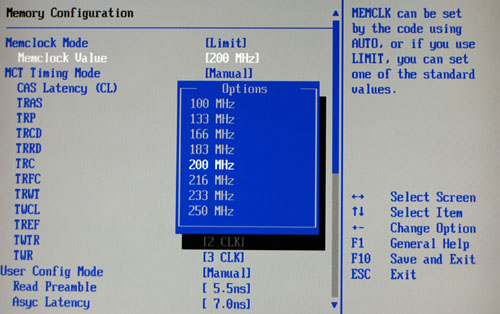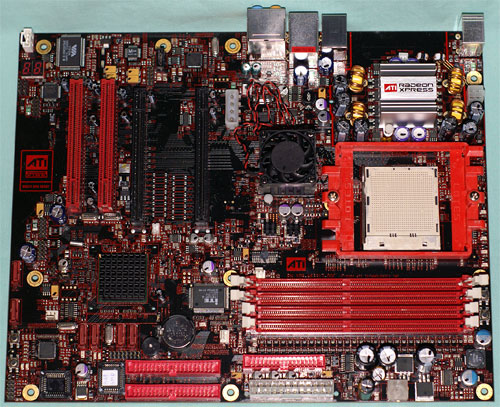
Original Link: https://www.anandtech.com/show/1800
ATI’s Crossfire: Best Overclocker on the Market?
by Wesley Fink on September 27, 2005 12:05 AM EST- Posted in
- CPUs
All of the ATI Crossfire attention seems to have concentrated on Crossfire Graphics performance. Most everyone found the X850 Crossfire to be roughly equivalent to NVIDIA 6800 Ultra SLI. However, the biggest story is not Crossfire graphics, but the launch of one of the most enthusiast-friendly chipsets ever produced by any manufacturer.
Those of you who have been following ATI's chipset development realize that the road to Crossfire has been a long one - perhaps too long. When AnandTech looked at the introduction of RX480/RS480 chipsets for AMD last November, we found the performance of the new chipsets to be very impressive. ATI had done a particularly excellent job targeting the enthusiast for the new chipset launch, but that realization seemed to come late in the chipset development process. This meant that this excellent chipset was largely ignored by motherboard manufacturers who had already pegged the new ATI parts for Micro ATX integrated video.
To ATI's credit, they have stayed the course of targeting the enthusiast, with a firm conviction that they could win the enthusiast with the right stuff, and that would mean penetration of the AMD market. Along the way, we have seen the original Bullhead board give way to Grouper (single GPU) and today's launch of Crossfire AMD (Halibut). Enthusiast-Level performance was an add-on for Bullhead, but Grouper and Halibut were designed from the ground up to satisfy the most demanding enthusiast.
The Intel side of the Radeon Xpress 200 came later, but ATI has also introduced, with little fanfare, the recent Jaguar board for Intel. This design culminates in Stingray (Crossfire Intel), which ATI also introduced today. While ATI did not provide Reference boards for Crossfire Intel testing, Crossfire Intel will ship at the same time, or shortly after Crossfire AMD. The AMD and Intel Crossfire solutions will be equivalent ATI chipset options. While this chipset performance review talks about ATI Crossfire AMD, keep in mind that there are potentially 8 new chipset board combinations with the new ATI chipsets. There are single video and dual video (Crossfire) versions for both AMD and Intel. There may also be an integrated graphics solution with any of these four combinations. Why would anyone want integrated graphics with this combination? Because, you can run additional monitors simultaneously with the add-on graphics. This opens many interesting possibilities for multi-monitor solutions.
The talk of Computex in early June was ATI's new Crossfire dual-video solution for AMD and Intel, which was on display for the world to see. However, it is now late September, almost 4 months after Computex, and we are finally seeing the ATI Reference boards for Crossfire. ATI tells us that they decided to wait for Crossfire release until boards and cards were ready for market. We have been able to confirm this, since we know from recent conversations with ECS, Gigabyte and Asus that Crossfire boards will appear very soon from these vendors. DFI will also have a full-blown performance oriented Crossfire released in October. There are also many other ATI Crossfire motherboards that will appear in the market very soon. Motherboards will definitely be available, but we have yet to see a Master video card for sale.
We have concentrated in this Reference Board review on the AMD side of ATI chipset performance with add-on graphics cards. We will talk more about Intel Jaguar/Crossfire Intel performance in a future article. We also will ignore integrated graphics from a performance viewpoint, even though all options can provide integrated graphics if the necessary Radeon Xpress 200 north bridge is used. The integrated video solutions basically combine on-board ATI X300 graphics limited to 2 pixel pipelines on either the AMD or Intel Radeon Xpress 200 chipset. You can read more about the performance of these integrated solutions in our review comparing ATI and Intel integrated graphics solutions.
About two months ago, we published benchmarks comparing Crossfire AMD to NVIDIA SLI and found Crossfire X850 XT to be very competitive with NVIDIA 6800 Ultra SLI - even with prerelease hardware and drivers. Of course, NVIDIA has since released the 7800GTX, which performs as a single card about the same as two 6800 Ultra cards running SLI. ATI does not have a comparable video card today that will compete with the 7800GTX, but ATI will be releasing the X1800 in the next couple of weeks. Keep this in mind when looking at any Crossfire reviews, as X1800 video cards in Crossfire mode will likely bridge the performance gap to single/dual NVIDIA 7800GTX graphics.
Yesterday, our Derek Wilson took a close look at the release Crossfire Graphics performance compared to NVIDIA SLI. However, this article will look more deeply at ATI Crossfire as a chipset. How does Crossfire perform compared to the best AMD chipsets on the market? What features will be available on ATI chipset boards? Of course, ATI has clearly targeted the AMD enthusiast with their new chipsets. With that in mind, the biggest question is whether ATI is worthy of consideration by AMD enthusiasts?
The ATI Xpress 200 Chipset Family
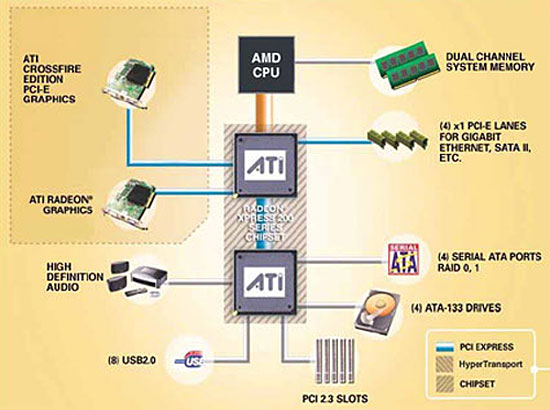
Last fall's introduction of the ATI AMD chipsets featured the SB400 south bridge. The recent introductions combine the north bridge with the ATI SB450 south bridge, which features High Definition Azalia audio for both AMD and Intel. This was the first chipset to bring High Definition audio to AMD. Recently, NVIDIA introduced the GeForce 6100 integrated graphic solution that also brings HD audio to AMD. However, NVIDIA's top nForce4 chipset, used in most enthusiast motherboards, does not support HD audio.
The SB 450 also supports PCI-e Gigabit LAN, standard SATA 150, and has improved USB burst performance compared to the earlier SB400 chipset. We will see full SATA 2 support and a completely reworked USB controller in the SB600, which will launch in the 4th quarter of this year.
The various ATI Radeon Xpress 200 north bridges can also be combined with ULi south bridges. The current ULi 1573 provides all the features of the ATI SB450 except integrated Gigabit Ethernet. This includes High Definition Azalia audio. Gigabit Ethernet can be added to the 1573 as an external chip. The ULi 1573 also supports NCQ hard drives, which are not supported on the SB450.
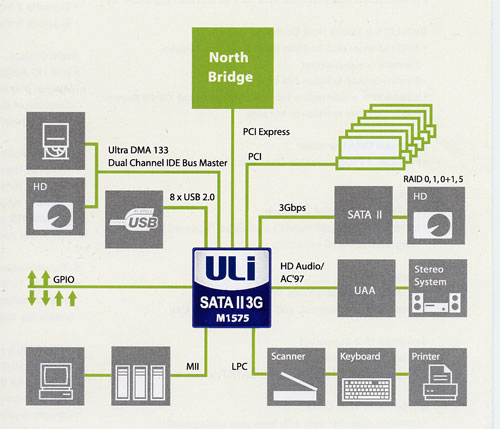
Basic Features: ATI Crossfire AMD Reference Board
| ATI Crossfire AMD Reference Board | |
| CPU Interface | Socket 939 Athlon 64 |
| Chipset | ATI RD480 Northbridge - ATI SB450 Southbridge |
| Bus Speeds | 200 to 500MHz in 1MHz Increments |
| Memory Speeds | DDR200,266,333,366,400,433,466,500 |
| PCIe Speeds | 100 to 200MHz in 1MHz increments |
| PCI/AGP | Fixed at 33/66 |
| Core Voltage | Auto, 0.825V to 1.55V in 0.025V increments PLUS .0V to 0.6V in 0.02V increments (Maximum vCore 2.15V) |
| CPU Clock Multiplier | 4x-25.5x in 0.5X increments |
| DRAM Voltage | Auto, 2.5V to 3.0V in .02V increments 3.0V to 4.0V in .05V increments (Maximun Memory Voltage 4.0V) |
| HyperTransport Frequency | 1000MHz (1GHz) |
| HyperTransport Multiplier | Auto, 1X to 5X |
| HyperTransport Voltage | 1.22V, 1.29V, 1.39V, 1.5V |
| Xpress 200 Voltage | 1.22V, 1.29V, 1.39V, 1.5V |
| PCIe 1.2 Voltage | 1.22V, 1.29 V, 1.39 V, 1.5V |
| PCIe 1.8 Voltage | 1.8V, 1.9V |
| Auto Overclocking | 1% to 15% |
| Memory Slots | Four 184-pin DDR DIMM Slots Dual-Channel Configuration Regular Unbuffered Memory to 4GB Total |
| Expansion Slots | 2 PCIe x16 2 PCI Slots |
| Onboard SATA/RAID | 4 SATA Drives by SB450 (RAID 0, 1, JBOD) 2 SATA II Drives by Sil 3231 |
| Onboard IDE/IDE RAID | Two Standard ATA133/100/66 (4 drives) |
| Onboard USB 2.0/IEEE-1394 | 8 USB 2.0 ports supported by SB450 2 1394 Firewire by VIA |
| Onboard LAN | Gigabit PCIe Ethernet by Marvel 88E8052 |
| Onboard Audio | Azalia HD Audio by Realtek ALC880 |
| BIOS | AMI Build 50 and Award Build 54 |
It is almost heresy to call the options and adjustments on the Crossfire AMD "Basic Features", since they are clearly the best that we have ever seen on any AMD motherboard. The DFI nForce4 Ultra and SLI boards have quickly developed a reputation for offering the enthusiast every imaginable BIOS option. We mention the DFI only to put in perspective that the ATI offers 2 more memory adjustments not found on the DFI, a wider range of vDIMM to 4.0V, and even more controls to tweak the performance of the motherboard. It is clear that ATI has worked with a lot of enthusiasts in refining the Crossfire AMD - it shows in the depth and breadth of available options.
At the other end of the spectrum, ATI also offers automatic overclocking options in the BIOS for those uncomfortable with manual overclocking. You can dial in 1% to 15% overclocking and the board handles all the adjustments for you.

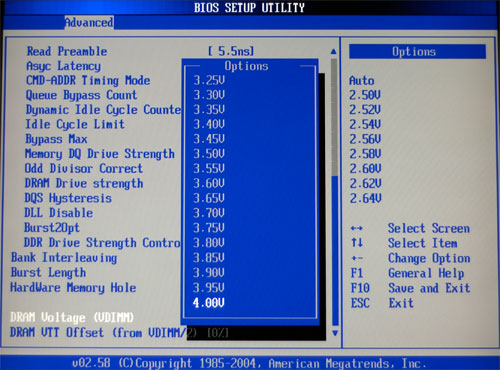
The ATI also has memory adjustments to DDR500 with the 4000+ Clawhammer processor that we use for standard benchmarking. The ability to run the processor at stock speed with memory at up to DDR500 opens new options for memory performance. You can do things like run the CPU at stock speed and the memory at DDR500.
Reference Boards are designed for qualification and we are certain that many would find the lack of any x1/x2 PCIe slots and just 2 PCI slots to be a concern if this were a production board. We saw a different slot arrangement on the Gigabyte ATI Crossfire AMD, and you will likely see many different slot configurations on production boards.
You may have noticed that the Gigabyte that we previewed several months ago controlled Crossfire with a "paddle board" similar to what we are accustomed to on NVIDIA. The AMD Reference Board does not use a paddle-card and all switching is done in the BIOS. In fact, the AMD Reference Board is capable of full auto-switching of single or dual video cards with no adjustments required in the BIOS if left in "Auto" mode. A number of video switching options are available to motherboard manufacturers.
Overclocking: ATI Crossfire AMD Reference Board
| Front Side Bus Overclocking Testbed | |
| Default Voltage | |
| Processor: | Athlon 64 4000+ (2.4GHz, 1MB Cache) |
| CPU Voltage: | 1.525V (default 1.50V) |
| Cooling: | Thermaltake Silent Boost K8 Heatsink/Fan |
| Power Supply: | OCZ Power Stream 520W |
| Memory: | OCZ PC3200 EL Platinum Rev. 2 (Samsung TCCD Memory Chips) |
| Hard Drive: | Seagate 120GB 7200RPM SATA 8MB Cache |
| Maximum OC: (Standard Ratio) |
245x12 (4x HT, 2.5-3-3-10) 2940MHz (+22.5%) |
| Maximum FSB: (Lower Ratio) |
315 x 9 (3x HT, 1T) (2835MHz, 2 DIMMs in DC mode) (+57.5% Bus Overclock) |
We have rarely tested a board with such incredible stability in overclocking. It was not always easy to reach our desired overclock with all of the options available in BIOS, but once we reached the overclock, it was exceptionally stable. We did notice that the ATI responds best to gradual increases in overclocking - it does not like, for example, to be set to 245 clock frequency. It will reach higher overclocks if the Clock frequency is increased gradually instead of one fell swoop. ATI has even added a "Gradual OC option" in BIOS to accommodate that reality.
The ATI Crossfire AMD reached a new record with our standard 4000+ Clawhammer. The highest previous overclock at stock multiplier was 240, but the ATI chipset went on to a stable 245. This would be quite an accomplishment for any board, but it is remarkable for a Reference board. The 315 Maximum bus frequency is also a great performance, second only to the DFI nForce4, which reached 318. We suspect that more time and tweaking may even have allowed us to break this record.
ATI clearly set out to build an enthusiast board that manufacturers could copy down to the smallest detail. Our advice to most manufacturers would be to copy the Reference Design. Unless you are certain that you can extract even more performance from this chipset, it is best to copy this top-performing Reference board.
At settings of 2T, we could reach even higher to a frequency of 325. There is a lot of discussion on the web these days claiming that you can minimize the impact of the 2T setting with certain options on Revision E AMD processors. We did not verify this claim in our tests, but we can tell you that all the talked-about options for 2T performance modes are in the memory timings section. It is little touches like these that tell us that enthusiasts in ATI or outside the company have had a big hand in the design of the Crossfire AMD.
TRas and Memory Stress Testing
Memory tRAS Recommendations
In past reviews, memory bandwidth tests established that a tRAS setting of 11 or 12 was generally best for nForce2, a tRAS of 10 was optimal for the nForce3 chipset, and a tRAS of 7 was optimal for the nForce4 chipset. The recently tested ULi 1695 was best at tRAS of 10.
In our first review of the AMD chipset in Sapphire PURE Innovation - ATI's Chipset for the AMD Enthusiast, we established that the optimum tRAS setting for the AMD chipset is 7 to 8. We therefore used a tRAS setting of 7 for all ATI Crossfire AMD testing.
Memory Stress Test
Our memory stress test measures the ability of the Crossfire ATI to operate at its officially supported memory frequency (400MHz DDR), at the lowest memory timings that OCZ PC3200 Platinum Rev. 2 modules will support. All DIMMs used for stress testing were 512MB double-sided (or double-bank) memory. To make sure that memory performed properly in Dual-Channel mode, memory was only tested using either one dual-channel (2 DIMMs) or 2 dual-channels (4 DIMMs).
| Stable DDR400 Timings - One Dual-Channel (2/4 DIMMs populated) |
|
| Clock Speed: | 200MHz |
| CAS Latency: | 2 |
| RAS to CAS Delay: | 2T |
| RAS Precharge: | 7T |
| Precharge Delay: | 2T |
| Command Rate: | 1T |
By using two DIMMs in Dual-Channel 128-bit mode, the memory performed in all benchmarks at the fastest 2-2-2-7 timings at default voltage.
| Stable DDR400 Timings - 4 DIMMs (4/4 DIMMs populated) |
|
| Clock Speed: | 200MHz |
| CAS Latency: | 2.0 |
| RAS to CAS Delay: | 2T |
| RAS Precharge: | 7T |
| Precharge Delay: | 2T |
| Command Rate: | 2T |
Tests with all four DIMM slots populated on the ATI required a 2T Command Rate with 4 DIMMs in two dual channels. This is the pattern seen on other top-performing Socket 939 boards with all current AMD chipset families. The Crossfire AMD had no problem running at a 200 CPU speed setting with 4 double-sided DIMMs. Since the Athlon 64 memory controller is on the processor, there were no real surprises in the memory stress tests. The ATI Crossfire AMD is certainly competitive with the best Socket 939 boards in memory performance.
Test Setup
| Performance Test Configuration | |
| Processor(s): | AMD Athlon 64 4000+ (2.4GHz) Socket 939 |
| RAM: | 2 x 512MB OCZ PC3200 Platinum Rev. 2 |
| Hard Drive(s): | Seagate 120GB 7200 RPM SATA (8MB Buffer) |
| Video AGP & IDE Bus Master Drivers: | ATI Catalyst Platform 5.8 NVIDIA Platform 6.66 |
| Video Cards: | ATI X850XT PE NVIDIA 6800 Ultra |
| Video Drivers: | ATI Catalyst 5.8 (8.161) NVIDIA nForce 77.77 |
| Operating System(s): | Windows XP Professional SP2 Direct X 9.0c |
| Motherboards: | ATI Crossfire AMD Reference Board SiS 756 Reference Board ASRock 939Dual-SATA2 (ULi M1695/1567) Sapphire A9RX480 (ATI) Jetway 939GT4-SLI-G (nForce4) ULi AP9567A (M1695/M1567) DFI LANParty UT nF4 Ultra-D (nForce4) MSI K8N Neo4/SLI Platinum (nForce4) |
Tests used OCZ PC3200 Platinum Rev. 2, which uses Samsung TCCD chips. All memory ran at 2-2-2-7 timing in all benchmarks.
We tested with our standard NVIDIA 6800 Ultra to allow the best comparisons to benchmark results with other motherboards. Resolution in all benchmarks is 1280x1024x32 unless otherwise noted.
General Performance and Encoding
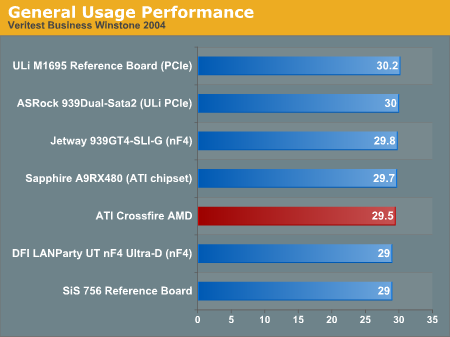
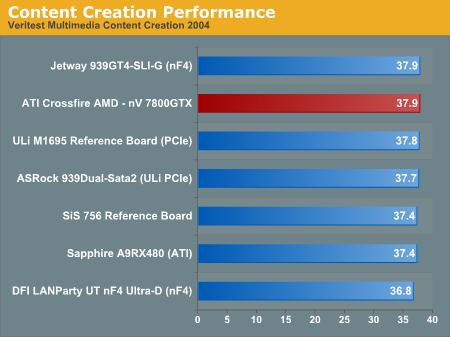

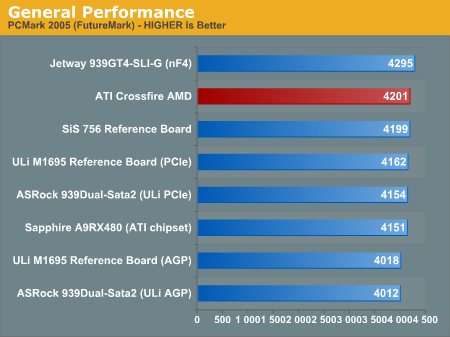
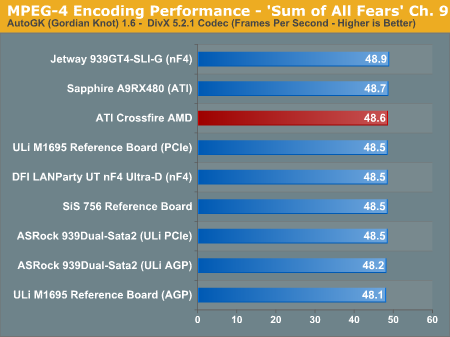
Auto GK encoding tests are all but unaffected by the graphics card, as we would expect. Encoding is more dependent on CPU speed and architecture, which is why you see little variation in a series of benchmarks run with the same Athlon 64 processor.
There is little to distinguish or detract from the ATI Crossfire AMD in General Performance benchmarks. The ATI board is competitive with the best Socket 939 Athlon 64 boards that we have tested.
Overclocking
In past reviews, we have discussed the importance of overclock test results - even if you never overclock. Everything about a board's quality comes together in these results, as it takes outstanding stability, great parts, and a good design to withstand the heat and stress of overclocking. This should matter to you even if you don't overclock, since it will tell you a great deal about a board's stability at stock speeds and the potential for a long board life.
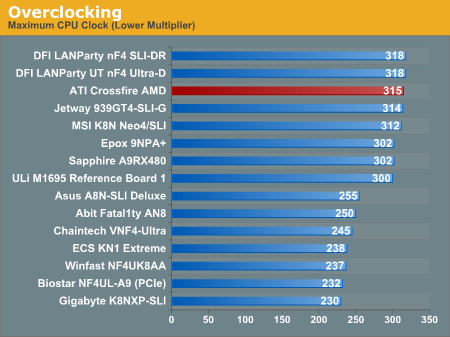
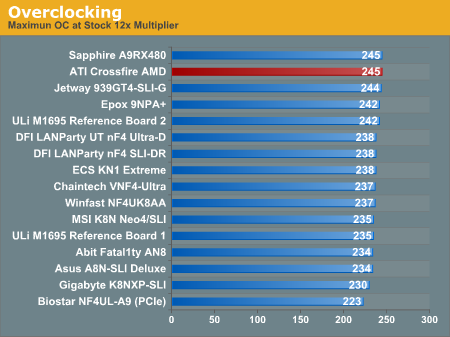
315 at lower multipliers is the second best performance we have ever achieved, exceeded only by the legendary DFI nForce4 SLI board. This places the ATI Crossfire AMD in the company of the few excellent overclocking Athlon 64 boards that have managed to reach a stable 50% or better frequency overclock at lower ratios.
ATI has made tremendous progress in board design since we looked at the initial Bullhead board last November. This Crossfire AMD seems the culmination of those efforts, with the best AMD chipset performance that we have ever tested. Earlier Grouper and Jaguar single-CPU boards have also likely benefited from AMD's continued improvement of Crossfire family boards. We hope ATI is also able to apply this design excellence to the ATI Crossfire Intel board.
Disk Controller Performance
With so many chipsets and brands of storage controllers on current Athlon 64 boards, we needed a means of comparing performance of the wide variety of controllers. The logical choice was Anand’s storage benchmark first described in Q2 2004 Desktop Hard Drive Comparison: WD Raptor vs the World. To refresh your memory, the iPeak test was designed to measure "pure" hard disk performance, and in this case, we kept the hard drive as consistent as possible while varying the hard drive controller. The idea is to measure the performance of a hard drive controller with a consistent hard drive. We played back Anand’s raw files that recorded I/O operations when running a real world benchmark - the entire Winstone 2004 suite. Intel's IPEAK utility was then used to play back the trace of all the IO operations that take place during a single run of Business Winstone 2004 and MCC Winstone 2004. To try to isolate performance difference to the controllers that we were testing, we used Seagate 7200.7 model SATA and IDE hard drives for all tests.
iPeak gives a mean service time in milliseconds; in other words, the average time that each drive took to fulfill each IO operation. In order to make the data more understandable, we report the scores as an average number of IO operations per second so that higher scores translate into better performance. This number does not represent a hard disk performance parameter as it is just the number of IO operations completed in a second. However, the scores are useful for comparing “pure” performance of the storage controllers in this case.
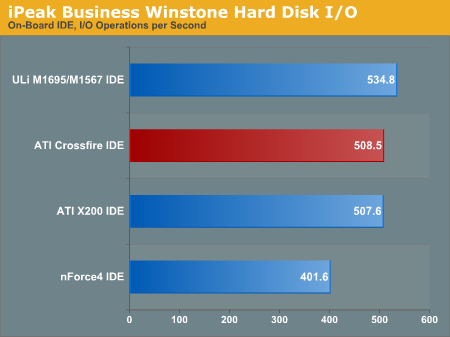
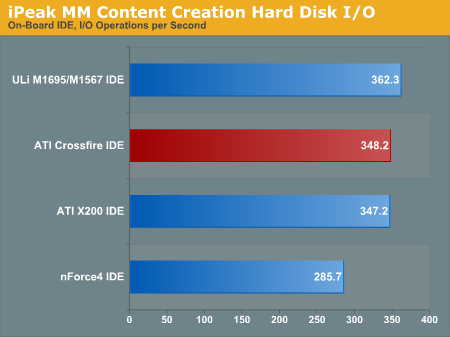
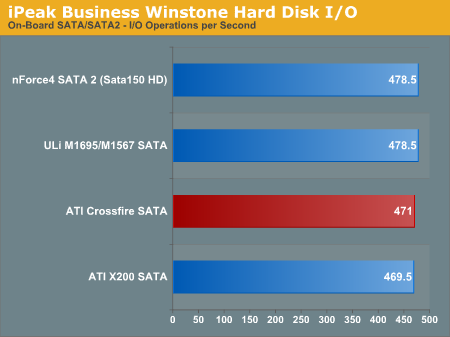
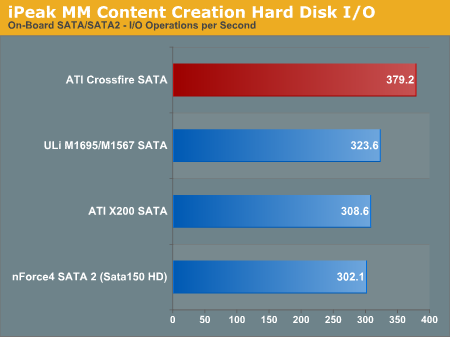
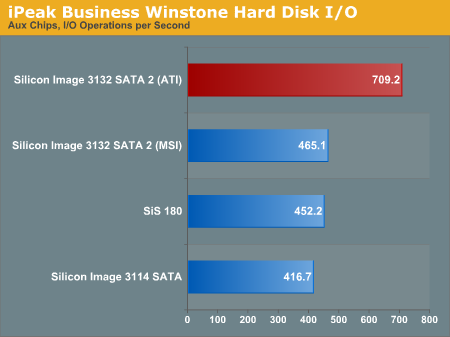
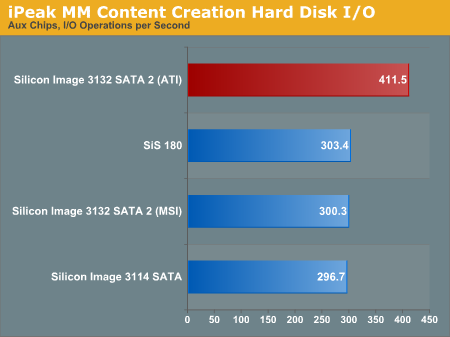
Firewire and USB Performance
It is really difficult to put together a simple, repeatable, and consistent test to measure USB and Firewire Performance. Since our goal was to make this a standard part of motherboard testing, we needed a benchmark that was reasonably simple to run and that would also provide consistent results on the same test bed. We finally determined that an external USB 2.0, Firewire 400, and Firewire 800 hard disk might be a sensible way to look at USB and Firewire throughput.
Our first efforts at testing with an IDE or SATA drive as the “server” yielded very inconsistent results, since Windows XP sets up cache schemes to improve performance. Finally, we asset up a RAM disk as our “server”, since memory removed almost all overhead from the serving end. We also managed to turn off disk caching on the USB and Firewire side by setting up the drives for “quick disconnect” and our results were then consistent over many test runs.
We used just 1GB of fast 2-2-2 system memory set up as a 450MB RAM disk and 550MB of system memory. Our stock file was the SPECviewPerf install file, which is 432,533,504 bytes (412.4961MB). After copying this file to our RAM disk, we measured the time for writing from the RAM disk to our external USB 2.0 or Firewire 400 or Firewire 800 drive using a Windows timing program written for AnandTech by our own Jason Clark. The copy times in seconds were then converted into Megabits per second (Mb) to provide a convenient means of comparing throughput. Higher Rates therefore mean better performance.
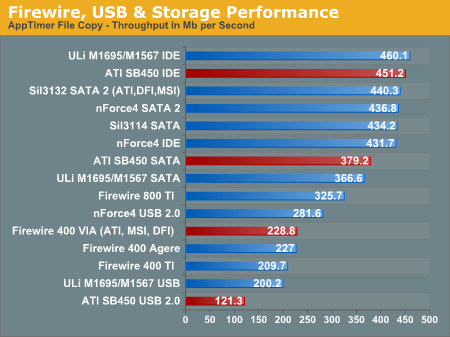
Perhaps the biggest surprise in our testing was the poor performance of USB 2.0 on the ATI Crossfire AMD. ATI had promised improvement in USB performance in the SB450 compared to the earlier SB400, but we could see little improvement in our USB 2.0 tests. ATI responded that our USB 2.0 tests measured sustained throughput, which is relevant in USB operations only with applications like the USB 2.0 hard drive that we use for this test. ATI claims that burst USB 2.0 throughput has been improved in the SB450 to near the same levels of competitive USB 2.0 peak performance. We could not confirm these claims with any test procedures. Perhaps more important, ATI is aware of the issues with USB 2.0 performance and these will be fully corrected – sustained and peak performance – in the SB600 south bridge. It appears that this issue of USB performance may also be corrected by combining the ATI RD480 northbridge with the just released ULi M1575 Southbridge.
Since our ramdisk/apptimer File Copy is measuring sustained throughput, we also compared performance of ATI IDE/SATA/Sil SATA2 using this same test procedure. The performance of ATI IDE remains excellent, but SATA and SATA 2 performance are very competitive, but not standout as in the iPeak storage benchmarks of the same controllers.
Ethernet Performance
Ethernet Performance is tested using a procedure first described in a VIA white paper. The Windows 2000 Driver Development Kit (DDK) includes a useful LAN testing utility called NTttcp. We used the NTttcp tool to test Ethernet throughput and the CPU utilization of the various Ethernet Controllers used on the nForce4 Ultra motherboards.
We set up one machine as the server; in this case, an Intel box with an Intel CSA Gigabit LAN connection. Intel CSA has a reputation for providing fast throughput and this seemed a reasonable choice to serve our Gigabit LAN clients. At the server side, we used the following Command Line as suggested by the VIA whitepaper on LAN testing:
Ntttcps - m 4,0,On the client side (the motherboard under test), we used the following Command Line:-a 4 - l 256000 - n 30000
Ntttcpr - m 4,0,At the conclusion of the test, we captured the throughput and CPU utilization figures from the client screen.-a 4 - l 256000 - n 30000
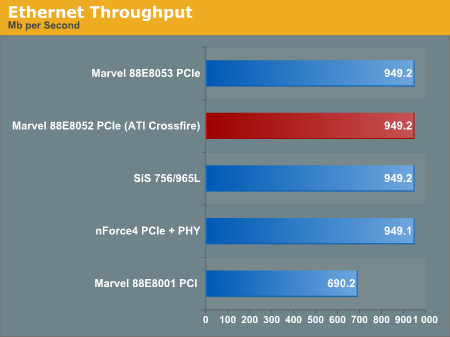
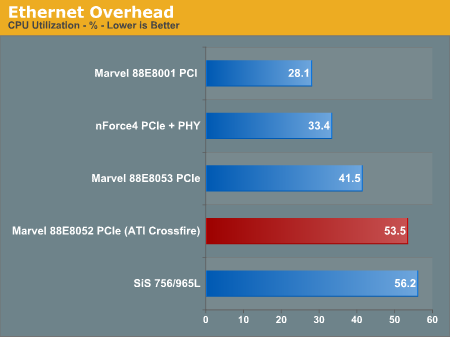
CPU utilization measurements for Gigabit Ethernet can be somewhat misleading, since they measure the percentage of CPU tie-up at sustained Gigabit receiving. In reality, it would be very rare that you would actually see sustained Gigabit transmission levels on your PC. For that reason, you should put the measured CPU utilization of Gigabit PCIe LAN in perspective. It will almost always be much lower than what we have measured.
Audio Performance
For audio testing, we used Rightmark 3D Sound CPU utilization test.. This benchmark measures the overhead or CPU utilization required by a codec or hardware audio chip.
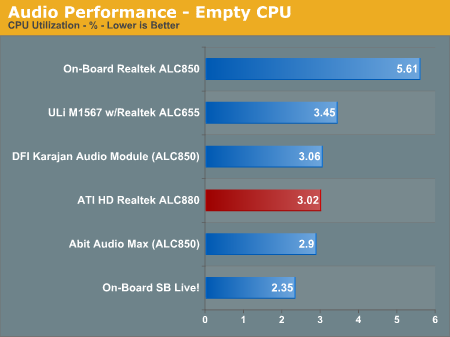

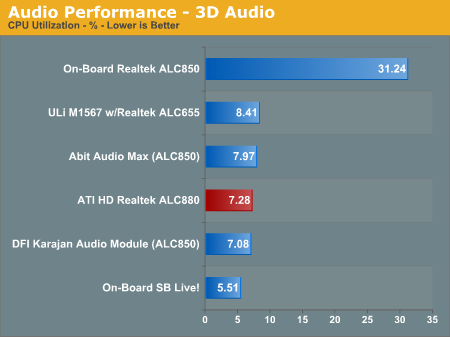
It is important to point out that the ATI Crossfire AMD is the first Athlon 64 board that we have seen to deliver Azalia High Definition audio. Those who have been complaining about the poor AC'97 audio present on most AMD boards should be very pleased to find Azalia HD on the ATI. While NVIDIA recently introduced their first HD audio solution, it is only targeted at the high end of the micro ATX integrated graphics market. nForce4 SLI motherboards, which will compete directly with ATI Crossfire AMD, do not currently offer High Definition audio.
We did some brief subjective listening tests with the ATI Azalia HD through a Dolby amplifier and a 5.1 speaker setup. The ATI Azalia HD was in a completely different league from the other audio solutions that we have tested on Athlon 64. Noise was virtually non-existent, and the imaging and depth were superb when listening to demanding recordings. The same CD sounded thin, noisy, and artificial through a more common ALC850 fed to the same Dolby amp and 5.1 speakers. This is not to say that the Azalia HD is at the same level as the very best audio cards, but it is a lot closer than we think that many of you imagine.
It is worth noting that ATI has implemented Azalia HD on the Crossfire AMD with the Realtek ALC880 chipset. This makes it easy for manufacturers to add Dolby Digital Live with "D" versions of this chipset, which are pin-compatible. For more information on the HD Realtek ALC880, go to the Realtek web site.
Final Words
With the introduction of ATI Crossfire, everyone found that Crossfire X850 is roughly equivalent in graphics performance to two NVIDIA 6800 Ultra cards in SLI mode. Of course, the NVIDIA 7800GTX is a more recent card that performs better than any current ATI video card. That conclusion will likely be tested again within the next two weeks when ATI X1800 is introduced to compete with the 7800GTX and the resulting new rounds of ATI X1800 testing. All of this is much as expected. However, the focus on Crossfire should not detract from the fact that ATI has arguably produced the best AMD enthusiast board that we have ever seen.
The ATI Crossfire AMD has every option a serious overclocker could wish for. This extends from CPU voltages that will even excite water cooling and phase-change enthusiasts, to memory voltages that will give an overclock voltage reserve to the most demanding OCZ VX and Mushkin Redline memory. In between are voltage adjustments for the chipset, HT Link, PCIe 1.2, and PCIe 1.8. Add a CPU clock frequency adjustment range of 200 to 500, PCIe from 100 to 200, a slew of memory settings from DDR200 to DDR500, and every memory tweak known to exist and you have an incredibly serious board for the overclocker and computer hobbyist.
The only real problem with this kind of board is that it sometimes is confusing and intimidating for those who don't eat, sleep, and breathe computers. Boards that can be tweaked to squeeze the most out of every kind of memory and every AMD CPU can be a beast for the uninitiated to control. ATI even thought of them with an "Auto Overclock" feature that allows the intimidated or frustrated to dial in an overclock %, up to 15%, and have the board handle all the details. Purists will scoff at this feature, but it wasn't designed for them anyway; it works quite well, and it allows new enthusiasts a cushion for the learning curve.
Of course, every adjustment option that you can think of would still be meaningless if they didn't deliver on performance, and the ATI Crossfire does this in spades. The ATI Crossfire AMD chipset reached the highest stock multiplier overclock ever with our standard 4000+ CPU, at 23%. It was also close to the highest clock frequency overclock at 1:1 memory that we have ever achieved at a 315 (DDR630) setting. While we have not concentrated on the quality of the components in this review, those in the know will be pleased with the 6-layer construction, components, design, and execution that allowed these incredible results. The ATI Crossfire AMD was designed for rock solid overclocking and long-term stability at extraordinary performance levels. That shows in performance, stability, and temperature control.
The ATI Crossfire AMD is not the perfect enthusiast board, but it is very close. We are frankly disappointed in the mediocre USB performance. ATI tells us that will be corrected with SB600 in about 6 months, but the correction will likely come much sooner with the ULi M1675 Southbridge that features decent USB and full SATA2 support. There is, however, little else to complain about from a performance standpoint. IDE, SATA, and Ethernet performance are exemplary, and some of the Reference Boards in the ATI series even came with integrated graphics just to prove that you don't have to compromise board performance just to have an integrated graphics option. The boards even pioneer Azalia High-Definition audio to AMD users with very low CPU utilization with the HD audio codecs.
In the end, the ATI Crossfire AMD is without a doubt the best enthusiast-oriented Reference Board that we have ever seen - with performance to match. Unfortunately, that does not mean that the retail boards that you will see with this chipset will be similarly endowed. Our advice to manufacturers is that this is one Reference Board worth copying. A manufacturer who faithfully copies this Reference Board and delivers the same performance as the Reference Board will have a winner on their hands.
Some manufacturers like DFI have committed to deliver a board as good or better than the ATI Crossfire AMD Reference. Others like Abit, Asus, Gigabyte, MSI, ECS, and Jetway will likely deliver exciting ATI Crossfire boards loaded with enthusiast features that may well match the ATI Crossfire AMD Reference performance.
In case the message is not crystal clear, it doesn't matter whether you want ATI Crossfire or not when you are considering buying an ATI chipset motherboard. Crossfire is slated for mainstream pricing, so it is definitely worthwhile to consider an ATI Crossfire AMD motherboard to drive your nVidia 7800GTX or 6800 Ultra or ATI X850 or the upcoming ATI X1800. They will all perform very well with any Athlon 64 processor on the ATI Crossfire AMD motherboard.
Yes, ATI Crossfire AMD is the first ATI motherboard to support dual-GPU graphics. However, the most important feature is the enthusiast level board supporting that option. NVIDIA captured the AMD market by catering to the AMD Enthusiast. The ATI Crossfire AMD is the first serious challenge to NVIDIA's dominance with the AMD Enthusiast. The bang may be late, but the message is clear - ATI is definitely for real in the AMD chipset market. In fact, they are clearing aiming for "Best-in-Class".

